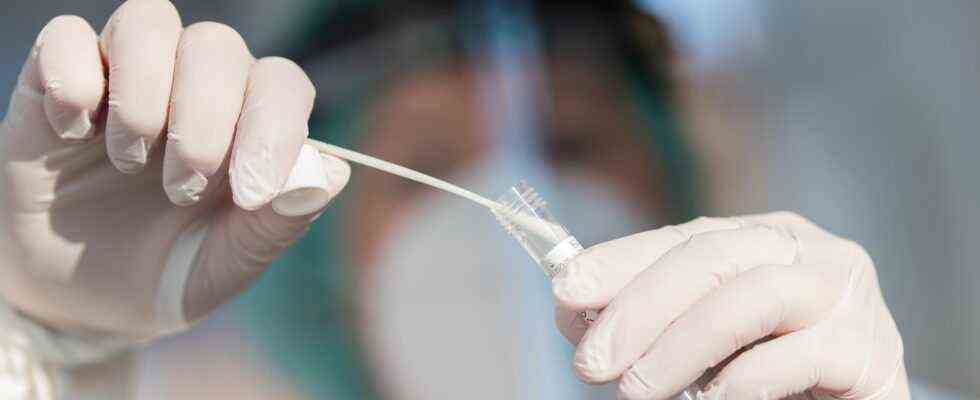Status: 01/13/2022 4:24 a.m.
The number of corona cases in Germany is increasing rapidly. In the north, laboratories hardly manage to evaluate all PCR tests. However, rapid tests alone are not sufficient if the incidence is high.
In the north they are breaking records at the moment. The incidence figures in Lübeck, for example, have never been as high as these days. That pushes the laboratories there to the limit. Within the past week, the number of samples has quadrupled, says the Lübeck physician and chairman of the professional association of German laboratory doctors, Andreas Bobrowski. “We currently have 50 percent positive tests in our laboratory.” He is concerned: “Nobody expected it to explode like this.”
The result is longer waiting times for the test evaluations – and prioritization: hospitals and nursing staff, for example, take precedence.
Getting a PCR test quickly has also become more difficult in other cities. At the same time, however, rapid tests are not an optimal alternative and in some cases they are also subject to criticism in terms of quality. “The rapid tests are only of limited use for asymptomatic patients,” emphasizes Bobrowski, who sees a free test from quarantine or isolation as critical.
Expand test capacities
Sepp Müller, deputy parliamentary group leader of the Union in the Bundestag, calls for mass PCR tests. “In view of Omikron, we have to expand capacities for community facilities, schools, nursing homes, but also overall.” He is skeptical of the federal government’s rapid test strategy, also with a view to the rules relating to 2G-Plus, and refers to Austria, above all Vienna, where PCR instead of antigen tests are now part of everyday life.
Janosch Dahmen, health politician for the Greens, is also in favor of more so-called PCR pool or series tests, in which the samples of a group, for example a school class, are combined. This normally saves material and time. Only if one of the samples is positive is a more precise re-test carried out. To this end, Germany must expand its test capacities – also in the long term, because this would probably still take a while.
Skilled workers are hard to find
In view of the number of cases, the utilization of laboratory capacities will probably increase everywhere in Germany, “to that extent it would be negligent to increase demand,” replied government spokesman Steffen Hebestreit in the federal press conference on questions about a general expansion of PCR testing. Opinions: Switching from antigen to PCR tests on a large scale in Germany is currently not an option.
Andreas Bobrowski confirms this. Reagents, i.e. chemicals and material for the PCR tests, are currently available in sufficient quantities, according to the laboratory doctor. But that’s not enough. Obtaining additional equipment is a problem – you are competing with other countries on the world market – but above all it is difficult to find even more specialists: “The analysis of PCR tests is a complex process that cannot be easily dealt with can be done quickly by trained staff. “
Laboratories in other regions are still not as busy as many laboratories in the north, but that will probably change very soon. In addition, the concept of pool tests no longer works well with high incidences – because in such a situation you have to retest in almost every pool group, and every single sample, which greatly increases the effort.
Only useful with low incidences
This is also signed by the Frankfurt virologist Sandra Ciesek. Serial testing only made sense if the incidence was low. So that means: You can’t get past the rapid antigen tests at the moment. Many experts see with a certain stomach ache that they primarily serve as door openers for leisure events, sport or gastronomy within the framework of 2G-Plus.
“Rapid antigen tests only work correctly in about half of the cases; we have known that for over a year,” says Ciesek. That has not fundamentally changed with Omikron either.
However, there are indications that the rapid tests at Omikron only turned out positive later in the course of an infection. It is still unclear whether this is due to the virus variant or the fact that many people are now vaccinated. “So far there have been too few and insufficiently extensive studies on the more precise effectiveness of the rapid tests in the case of Omikron,” said Ciesek.
Differences in quality in rapid tests
Ciesek also sees great differences in quality in the various rapid tests and also refers to the application: “If you do not take the smear correctly, the best test may not be of any use.” This also applies to the question of how well the freestyle works at the end of an infection.
Contrary to rumors to the contrary, it has not yet been conclusively clarified whether a nasal or throat swab is the better approach with Omikron. Laypeople should carry out self-tests according to the package insert and, if necessary, repeat them after a few hours if the result is initially negative, but symptoms are evident. “On the other hand, it is clear that if the rapid test is positive with the currently high incidence figures, you are very likely infected,” said Ciesek.
Prioritization of certain groups
With regard to the increasingly scarce PCR tests, the virologist calls for certain groups to be clearly prioritized, as provided for in the national test strategy: symptomatic cases and personnel in health care and systemically important professions first.
Laboratory physician Bobrowski could also imagine adapting the test strategy. Employees in the critical infrastructure, but also asymptomatic cases, which very likely had direct contact with corona, should be tested with PCR as a priority. In the event of a deficiency in symptomatic patients, one could initially switch to rapid tests – provided that the quality and application of the tests are correct.

